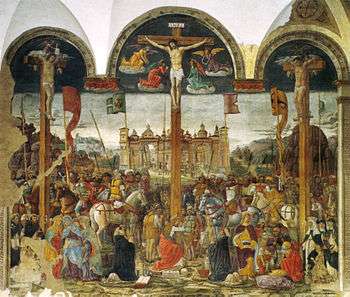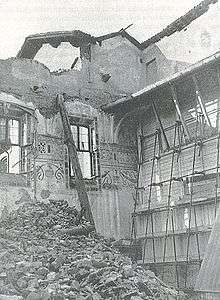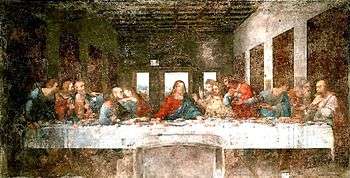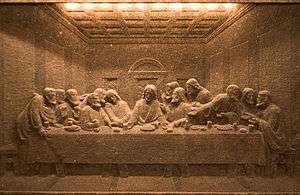The Last Supper (Leonardo da Vinci)
 | |
| Artist | Leonardo da Vinci |
|---|---|
| Year | 1495-1498 |
| Type | tempera on gesso, pitch, and mastic |
| Dimensions | 460 cm × 880 cm (181 in × 346 in) |
| Location | Santa Maria delle Grazie, Milan |
| Coordinates: 45°28′00″N 9°10′15″E / 45.46667°N 9.17083°E | |
The Last Supper (Italian: Il Cenacolo [il tʃeˈnaːkolo] or L'Ultima Cena [ˈlultima ˈtʃeːna]) is a late 15th-century mural painting by Leonardo da Vinci in the refectory of the Convent of Santa Maria delle Grazie, Milan. It is one of the world's most famous paintings.[1]
The work is presumed to have been commenced around 1495-1496 and was commissioned as part of a plan of renovations to the church and its convent buildings by Leonardo's patron Ludovico Sforza, Duke of Milan. The painting represents the scene of The Last Supper of Jesus with his disciples, as it is told in the Gospel of John, 13:21. Leonardo has depicted the consternation that occurred among the Twelve Disciples when Jesus announced that one of them would betray him.
Due to the methods used, and a variety of environmental factors, as well as intentional damage, very little of the original painting remains today, despite numerous restoration attempts, the last being completed in 1999.
Painting


_-_WGA12732.jpg)
The Last Supper measures 460 cm × 880 cm (180 in × 350 in) and covers an end wall of the dining hall at the monastery of Santa Maria delle Grazie in Milan, Italy. The theme was a traditional one for refectories, although the room was not a refectory at the time that Leonardo painted it. The main church building had only recently been completed (in 1498), but was remodeled by Bramante, hired by Ludovico Sforza to build a Sforza family mausoleum.[2] The painting was commissioned by Sforza to be the centerpiece of the mausoleum.[3] The lunettes above the main painting, formed by the triple arched ceiling of the refectory, are painted with Sforza coats-of-arms. The opposite wall of the refectory is covered by the Crucifixion fresco by Giovanni Donato da Montorfano, to which Leonardo added figures of the Sforza family in tempera. (These figures have deteriorated in much the same way as has The Last Supper.) Leonardo began work on The Last Supper in 1495 and completed it in 1498—he did not work on the painting continuously. The beginning date is not certain, as the archives of the convent for the period have been destroyed, and a document dated 1497 indicates that the painting was nearly completed at that date.[4] One story goes that a prior from the monastery complained to Leonardo about the delay, enraging him. He wrote to the head of the monastery, explaining he had been struggling to find the perfect villainous face for Judas, and that if he could not find a face corresponding with what he had in mind, he would use the features of the prior who complained.[5][6]

The Last Supper specifically portrays the reaction given by each apostle when Jesus said one of them would betray him. All twelve apostles have different reactions to the news, with various degrees of anger and shock. The apostles are identified from a manuscript[7] (The Notebooks of Leonardo da Vinci p. 232) with their names found in the 19th century. (Before this, only Judas, Peter, John and Jesus were positively identified.) From left to right, according to the apostles' heads:
- Bartholomew, James, son of Alphaeus, and Andrew form a group of three; all are surprised.
- Judas Iscariot, Peter, and John form another group of three. Judas is wearing green and blue and is in shadow, looking rather withdrawn and taken aback by the sudden revelation of his plan. He is clutching a small bag, perhaps signifying the silver given to him as payment to betray Jesus, or perhaps a reference to his role within the 12 disciples as treasurer.[8] He is also tipping over the salt cellar. This may be related to the near-Eastern expression to "betray the salt" meaning to betray one's Master. He is the only person to have his elbow on the table and his head is also horizontally the lowest of anyone in the painting. Peter looks angry and is holding a knife pointed away from Christ, perhaps foreshadowing his violent reaction in Gethsemane during Jesus' arrest. The youngest apostle, John, appears to swoon.
- Jesus
- Apostle Thomas, James the Greater, and Philip are the next group of three. Thomas is clearly upset; the raised index finger foreshadows his incredulity of the Resurrection. James the Greater looks stunned, with his arms in the air. Meanwhile, Philip appears to be requesting some explanation.
- Matthew, Jude Thaddeus, and Simon the Zealot are the final group of three. Both Jude Thaddeus and Matthew are turned toward Simon, perhaps to find out if he has any answer to their initial questions.
_04.jpg) | |
|
|
In common with other depictions of the Last Supper from this period, Leonardo seats the diners on one side of the table, so that none of them has his back to the viewer. Most previous depictions excluded Judas by placing him alone on the opposite side of the table from the other eleven disciples and Jesus, or placing halos around all the disciples except Judas. Leonardo instead has Judas lean back into shadow. Jesus is predicting that his betrayer will take the bread at the same time he does to Saints Thomas and James to his left, who react in horror as Jesus points with his left hand to a piece of bread before them. Distracted by the conversation between John and Peter, Judas reaches for a different piece of bread not noticing Jesus too stretching out with his right hand towards it (Matthew 26: 23). The angles and lighting draw attention to Jesus, whose head is located at the vanishing point for all perspective lines.
The painting contains several references to the number 3, which represents the Christian belief in the Holy Trinity. The Apostles are seated in groupings of three; there are three windows behind Jesus; and the shape of Jesus' figure resembles a triangle. There may have been other references that have since been lost as the painting deteriorated.
Important copies
Two early copies of The Last Supper are known to exist, presumed to be work by Leonardo's assistants. The copies are almost the size of the original, and have survived with a wealth of original detail still intact.[10] One accurate copy, by Giampietrino, is in the collection of the Royal Academy of Arts, London, and the other, with some alterations to the background design, by Cesare da Sesto, is installed at the Church of St. Ambrogio in Ponte Capriasca, Switzerland. A third copy (oil on canvas) is painted by Andrea Solari (ca. 1520) and is currently at display in the Leonardo da Vinci Museum of the Tongerlo Abbey, Belgium.
Medium
For this work, Leonardo sought a greater detail and luminosity than could be achieved with traditional fresco.[11] He painted The Last Supper on a dry wall rather than on wet plaster, so it is not a true fresco. Because a fresco cannot be modified as the artist works, Leonardo instead chose to seal the stone wall with a double layer of dried plaster.[11] Then, borrowing from panel painting, he added an undercoat of white lead to enhance the brightness of the oil and tempera that was applied on top. This was a method that had been described previously, by Cennino Cennini in the 14th century. However, Cennini had recommended the use of secco for the final touches alone.[12] These techniques were important for Leonardo's desire to work slowly on the painting, giving him sufficient time to develop the gradual shading or chiaroscuro that was essential in his style.
Damage and restorations

Because the painting was on a thin exterior wall, the effects of humidity were felt more keenly, and the paint failed to properly adhere to the wall. Because of the method used, soon after the painting was completed on February 9, 1498 it began to deteriorate.[11] As early as 1517, the painting was starting to flake. By 1556 — fewer than sixty years after it was finished — Leonardo's biographer Giorgio Vasari described the painting as already "ruined" and so deteriorated that the figures were unrecognizable. By the second half of the sixteenth century Gian Paolo Lomazzo stated that, “…the painting is all ruined.”[11] In 1652, a doorway was cut through the (then unrecognisable) painting, and later bricked up; this can still be seen as the irregular arch shaped structure near the center base of the painting. It is believed, through early copies, that Jesus' feet were in a position symbolizing the forthcoming crucifixion. In 1768, a curtain was hung over the painting for the purpose of protection; it instead trapped moisture on the surface, and whenever the curtain was pulled back, it scratched the flaking paint.
A first restoration was attempted in 1726 by Michelangelo Bellotti, who filled in missing sections with oil paint then varnished the whole mural. This repair did not last well and another restoration was attempted in 1770 by an otherwise unknown artist named Giuseppe Mazza. Mazza stripped off Bellotti's work then largely repainted the painting; he had redone all but three faces when he was halted due to public outrage. In 1796, French revolutionary anti-clerical troops used the refectory as an armory; they threw stones at the painting and climbed ladders to scratch out the Apostles' eyes. The refectory was then later used as a prison; it is not known if any of the prisoners may have damaged the painting. In 1821, Stefano Barezzi, an expert in removing whole frescoes from their walls intact, was called in to remove the painting to a safer location; he badly damaged the center section before realizing that Leonardo's work was not a fresco. Barezzi then attempted to reattach damaged sections with glue. From 1901 to 1908, Luigi Cavenaghi first completed a careful study of the structure of the painting, then began cleaning it. In 1924, Oreste Silvestri did further cleaning, and stabilised some parts with stucco.
During World War II, on August 15, 1943, the refectory was struck by Allied bombing; protective sandbagging prevented the painting from being struck by bomb splinters, but it may have been damaged further by the vibration. From 1951 to 1954, another clean-and-stabilise restoration was undertaken by Mauro Pelliccioli.
Major restoration

The painting's appearance by the late 1970s had become badly deteriorated. From 1978 to 1999, Pinin Brambilla Barcilon guided a major restoration project which undertook to stabilize the painting, and reverse the damage caused by dirt and pollution. The 18th- and 19th-century restoration attempts were also reverted. Since it had proved impractical to move the painting to a more controlled environment, the refectory was instead converted to a sealed, climate-controlled environment, which meant bricking up the windows. Then, detailed study was undertaken to determine the painting's original form, using scientific tests (especially infrared reflectoscopy and microscopic core-samples), and original cartoons preserved in the Royal Library at Windsor Castle. Some areas were deemed unrestorable. These were re-painted using watercolor in subdued colors intended to indicate they were not original work, while not being too distracting.
This restoration took 21 years and, on 28 May 1999, the painting was returned to display. Intending visitors were required to book ahead and could only stay for 15 minutes. When it was unveiled, considerable controversy was aroused by the dramatic changes in colors, tones, and even some facial shapes. James Beck, professor of art history at Columbia University and founder of ArtWatch International, had been a particularly strong critic.[13] Michael Daley, director of ArtWatch UK, has also complained about the restored version of the painting. He has been critical of Christ's right arm in the image which has been altered from a draped sleeve to what Daley calls "muff-like drapery".[14]
The Last Supper in culture

The Last Supper has frequently been referenced, reproduced, or parodied in Western culture. Some of the more notable examples are:
Painting, mosaic, and photography
A 16th-century oil on canvas copy is conserved in the abbey of Tongerlo, Antwerp, Belgium. It reveals many details that are no longer visible on the original. The Roman mosaic artist Giacomo Raffaelli made another life-sized copy (1809–1814) in the Viennese Minoritenkirche.
Modern art
In 1955, Salvador Dalí painted The Sacrament of the Last Supper, with Jesus portrayed as blond and clean shaven, pointing upward to a spectral torso while the apostles are gathered around the table heads bowed so that none may be identified. It is reputed to be one of the most popular paintings in the collection of the National Gallery of Art in Washington, D.C.
In 1986, Andy Warhol was commissioned to produce a series of paintings based on The Last Supper that were exhibited initially in Milan. This was his last series of paintings before his death.[15]
Sculptor Marisol Escobar rendered The Last Supper as a life-sized, three-dimensional, sculptural assemblage using painted and drawn wood, plywood, brownstone, plaster, and aluminum. This work, Self-Portrait Looking at The Last Supper, (1982–84) is in New York's Metropolitan Museum of Art.[16]
In 2001, Chinese artist Zeng Fanzhi painted Last Supper, showing 13 mask-wearing people seated at a table strewn with watermelon fragments. The oil painting was sold for $23.3 million at Sotheby's auction on October 7, 2013, setting a new record for contemporary Asian artwork.[17]
In 1998, modern artist Vik Muniz displayed a recreation of The Last Supper, made entirely out of Bosco Chocolate Syrup.[18]
Literature
Author Mary Shelley describes her impression of the painting in her travel narrative, Rambles in Germany and Italy published in 1844:
First we visited the fading inimitable fresco of Leonardo da Vinci. How vain are copies! not in one, nor in any print, did i ever see the slightest approach to the expression in our Saviour's face, such as it is in the original. Majesty and love — these are the words that would describe it — joined to an absence of all guile that expresses the divine nature more visibly than I ever saw it in any other picture.[19]— Mary Shelley, Travel Writing (1996), Pages 131–132
Film
In Luis Buñuel's Spanish film Viridiana, a tableau vivant of Leonardo's painting is staged with beggars. Another beggar 'photographs' the scene by flashing them. This scene contributed to its refusal by the Vatican who called it "blasphemous."
The painting is parodied in Mel Brooks's movie History of the World, Part I, making Leonardo a contemporary of Jesus.
Other speculation
The Last Supper has been the target of much speculation by writers and historical revisionists alike, usually centered on purported hidden messages or hints found within the painting, notably since the publication of the novel The Da Vinci Code by Dan Brown in 2003.
Dan Brown proposed that the person to Jesus' right (left of Jesus from the viewer's perspective), was not John the Apostle, but Mary Magdalene. This speculation was copied from earlier books The Templar Revelation (1997) by Lynn Picknett and The Holy Blood and the Holy Grail by Michael Baigent, Henry Lincoln and Richard Leigh (1982). These claims have been contested by other writers, such as Carl E. Olsen and Sandra Miesel in The Da Vinci Hoax, as well as by art historians. Christopher Hodapp and Alice Von Kannon commented "If he [John] looks effeminate and needs a haircut, so does James, the second figure on the left, the one with the sort of Bette Midler look about him". [20]
Giovanni Maria Pala, an Italian musician, has indicated that the positions of hands and loaves of bread can be interpreted as notes on a musical staff and, if read from right to left, as was characteristic of Leonardo's writing, form a musical composition.[21][22][23]
Notes
- ↑ "Leonardo Da Vinci's 'The Last Supper' reveals more secrets". sciencedaily.com. Retrieved March 3, 2014.
- ↑ "Santa Maria delle Grazie & The Last Supper". Timeout.com. Retrieved 2012-12-21.
- ↑ "Leonardo's Itinerary: Early maturity in Milan (1482-1499)". Museo Galileo. 5 March 2008. Retrieved 2012-12-21.
- ↑ Kenneth Clark.Leonardo da Vinci, Penguin Books 1939, 1993, p144.
- ↑ "The Last Supper". lairweb.org.nz. Retrieved 2012-12-21.
- ↑ "DaVinci". The Mark Steel Lectures. Series 2. Episode 2. The Open University. 7 October 2003. BBC. Retrieved 2012-12-21.
- ↑ "The Notebooks of Leonardo Da Vinci — Complete by Leonardo da Vinci". Gutenberg.org. 1 January 2004. Retrieved 2012-02-14.
- ↑ Cfr. Matthew 26:15; John 12:6 and 13:29.
- ↑ "Leonardo's Last Supper". Smarthistory at Khan Academy. Retrieved February 11, 2013.
- ↑ "Last Supper (copy after Leonardo)". University of the Arts, London. Retrieved 2008-08-11.
- 1 2 3 4 "Leonardo's Last Supper". Smart history presented by the Khan Academy. Retrieved 25 February 2014.
- ↑ "The Last Supper". The Last Supper. Retrieved 25 February 2014.
- ↑ Phillip William (24 May 1999). "The Last Supper or a dog's dinner?". The Guardian. guardian.co.uk. Retrieved 2012-12-21.
- ↑ Dayla Alberge (14 March 2012). "Have art restorers ruined Leonardo's masterpiece?". The Independent. Retrieved 2012-12-21.
- ↑ Haden-Guest, Anthony (3 August 1999). "Warhol's Last Supper". Artnet. Retrieved 2010-03-12.
- ↑ "Self-Portrait Looking at The Last Supper". Metropolitan Museum of Art. Retrieved 2012-12-21.
- ↑ "Zeng's 'Last Supper' Sells for Record $23.3 Million at Sotheby's Auction". WSJ.com. October 7, 2013.
- ↑ Goldberg, Vicki (25 September 1998). "ART REVIEW; It's a Leonardo? It's a Corot? Well, No, It's Chocolate Syrup". The New York Times. Retrieved 2012-12-21.
- ↑ Shelley, Mary (1996). Travel Writing. London: Pickering. pp. 131–132. ISBN 1-85196-084-8.
- ↑ Christopher Hodapp, Alice Von Kannon, The Templar Code For Dummies, page 257 (Wiley Publishing, Inc., 2007. ISBN 978-0-470-12765-0).
- ↑ Rossella Lorenzi (9 November 2007). "Leonardo's 'Last Supper' Hides True Da Vinci Code". Discovery News. Retrieved 2012-12-21.
- ↑ "Da Vinci's "Last Supper" has hidden music (includes link to recording)". Extra.beloblog.com. Retrieved 2009-02-08.
- ↑ mp3 file of the composition, hosted.ap.org
Further reading
- Steinberg, Leo. Leonardo's Incessant 'Last Supper'". New York: Zone Books, 2001.
- Detailed review of Steinberg's 'Incessant Last Supper' at 3 Pipe Problem
- Bertelli, Carlo (November 1983). "Restoration Reveals The Last Supper". National Geographic. Vol. 164 no. 5. pp. 664–684. ISSN 0027-9358. OCLC 643483454.
External links
| Wikimedia Commons has media related to Last Supper by Leonardo da Vinci. |
- Official website
- Leonardo's Last Supper and the three layers
- John the Apostle in Art
- Leonardo da Vinci: anatomical drawings from the Royal Library, Windsor Castle, exhibition catalog fully online as PDF from The Metropolitan Museum of Art, which contains material on The Last Supper (see index)